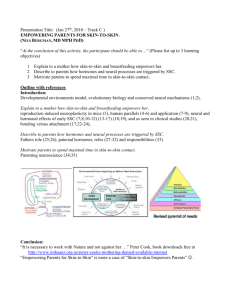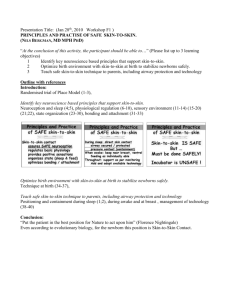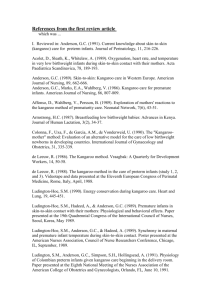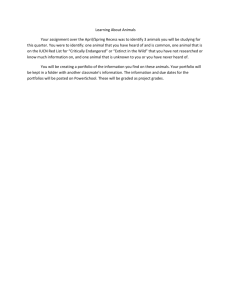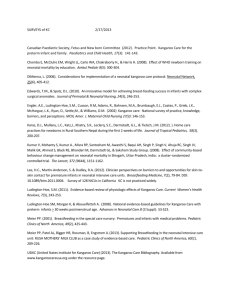Skin to Skin Holding
advertisement
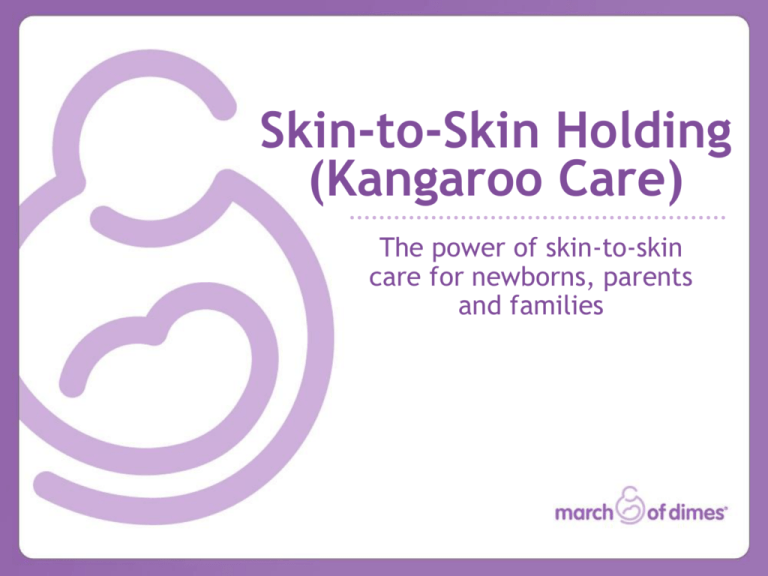
Skin-to-Skin Holding (Kangaroo Care) The power of skin-to-skin care for newborns, parents and families March of Dimes Mission To improve the health of babies by preventing birth defects, premature birth and infant mortality. Fund Research Help Moms Support Families to understand the problem and discover answers. have full-term pregnancies and healthy babies. comforting them when their baby needs help to survive and thrive. 2 Parenthood begins with that first touch. Did you know… …According to some NICU parents, the first time they considered themselves real parents was the first time a nurse encouraged them to hold their baby skin-to-skin? How soon can we encourage this bonding activity between baby and parent? What are some obstacles stopping you from suggesting skin-to-skin holding to a parent? Common obstacles • • • • • Inconsistent criteria/standards Difficulty assessing newborn readiness Staff concern about adverse events (extubation, etc.) Lack of knowledge about depth of benefits Staff concern about workload, time, space, multiple staff needed (Engler et al., 2002) Kangaroo care enables moms to regain the temporarily lost relationship with their child, and enables fathers to experience the beginning of a new relationship. (Fegran et al., 2008) “If a baby can be transferred to a scale for weighing, a baby can be transferred to a parent for skin-to-skin holding.” Robert White, M.D., Neonatologist Pediatrix Medical Group Memorial Hospital, South Bend, Indiana What is skin-to-skin holding? • A holding technique, skin-to-skin, chest-to-chest, in an upright position where the baby is only wearing a diaper on the parent’s bare chest (Ludington-Hoe et al., 1998) • A non-invasive, supportive, and natural early intervention for preterm infants (Dombrowski et al., 2000) • It’s also known as “kangaroo care” and has been the subject of more than 263 studies. A mother in Nebraska enjoying a special skin-to-skin moment with her daughter, Ava. Who thinks skin-to-skin holding is important? • March of Dimes (2001-current) promotes skin-to-skin holding in its educational literature, program materials and throughout the NICU Family Support® program. • World Health Organization (WHO, 2003) Kangaroo Mother Care: A Practical Guide. • American Academy of Pediatrics (AAP, 2005) A Sample Hospital Breastfeeding Policy for Newborns. Cites the benefits of skin-to-skin holding on milk letdown and parental bonding. • National Association of Neonatal Nurses.Transfer Procedure for Ventilated Kangaroo Care (NANN, 2008) at www.nann.org. Selected, proven benefits to baby: apnea, brady, O2 sat, heart rate • Four-fold decrease in apnea; mechanically ventilated babies able to tolerate transfer and position changes without increased oxygen requirements. (Cleary et al., 1997; Hunt, 2008) • Holding skin-to-skin did not increase bradycardia episodes. (Gale, Vandenberg, 1998) • Heart rate was more regular for infants held skin-to-skin. (Aucott et al., 2002) • Kangaroo care has proven successful in improving survival rates of premature and low birth weight newborns and in lowering the risks of nosocomial infection (Conde-Agudelo, Diaz-Rossello, & Belizan, 2003). Selected, proven benefits to baby: body temperature and lactation • Thermal synchrony between mothers and their babies was shown. (Ludington-Hoe et al., 2006) • Mothers increased their milk volume, doubled rates of successful breastfeeding and increased duration of breastfeeding with skin-to-skin holding. (Mohrbacher & Stock, 2003) • Physiologically a mother’s breasts respond to her infant’s thermal needs. (Ludington-Hoe et al., 2006) • Babies held skin-to-skin had fewer breastfeeding difficulties. (Tessier et al., 2003) Selected, proven benefits to baby: sleep, memory, neurodevelopment • Enhanced neurological development was shown. (Ferber, Makhoul, 2004) • Babies spent more time in sleep; shown as necessary for neurosensory development, preservation of brain plasticity, learning and long-term memory. (Graven, 2008) • Skin-to-skin holding increased the maturation rate of circadian system; secondary to favorable oscillation between quiet sleep and wakefulness. (Feldman et al., 2002) • Skin-to-skin holding accelerated autonomic maturation, as shown by greater gains in vagal tone. (Feldman et al., 2003) Benefits to mom & dad: bonding, attachment, confidence • Holding skin-to-skin and breastfeeding increase levels of oxytocin in mothers, enhancing attachment to their infant and their sense of motherhood. (Ferber, Markhoul, 2004; Morrison, 2006) • Holding skin-to-skin improved bonding and attachment in babies of teen parents. (Wang YH, Kuo HH, 2006) • Increased confidence in parenting skills was shown with skin-to-skin holding. (Charpak et al., 2005) • Skin-to-skin holding increased sense of control in parents. (VandenBerg, 2000) Benefits to mom & dad: parental comfort and healing • “Skin-to-skin holding may lessen maternal depression.” (De Alencar et al., 2009) • Skin-to-skin holding promotes a sensory dialogue between parents and infants. (Gayle & VandenBerg, 1998) • Holding skin-to-skin reduced postpartum depression and anxiety symptoms. (Anderson et al., 2003) • A reduction in father’s fears of “breaking baby” was shown with skinto-skin holding. (Bauer et al., 1996) Benefits to mom & dad: bereavement and palliative care • Palliative care embraces the baby as a whole, taking into consideration physical, emotional, spiritual and social needs, along with the needs of the family. • Offer the option of skin-to-skin holding and photography with a family whose baby is dying. Invite the whole family to participate. These may be the only family photographs they receive. Infants who are not ready • • • • Any clinically unstable infant Infant with a chest tube Post-op surgical infant Infant who would experience intense pain from being transferred (Osteogenesis Imperfecta diagnosis, etc.) • Exceptions can be made on a case-by-case basis, with a physician’s order. If infants are not ready for skin-to-skin holding, encourage the following: • • • • Gentle, still touch Hand swaddling (hand hugs) Breast pumping Reading at the bedside How can we improve our practice? • Develop guidelines. • Develop teaching plan for family. • Develop ongoing teaching plan for staff. • Develop teaching plan for mothers on the antepartum unit before NICU admission. • Continue to encourage skinto-skin holding even after a baby graduates to wearing clothes. • Encourage families to hold skin-to-skin at home after discharge. Enhancing the skin-to-skin experience privacy screen hand held mirror standing mirror zero gravity chair Enhancing the transfer process Transfer Procedure for Ventilated Kangaroo Care wall poster Nann.org What We Say Can Help, Hurt or Heal “Your baby’s heart rate is dropping. It’s time to put her back.” “He looks so peaceful in your arms.” “You’re doing such a great job.” “You are not holding him right. He’s not comfortable.” “I will never forget the first time my newborn was placed on my chest. She was so tiny, so fragile, but she curled right up into me, as if she instinctively knew that’s where she belonged. It was the closest I’d been to her since she’d been inside me. In that moment, I finally felt like a mother. This child was mine. Those moments (when we kangarooed) would fast become my favorite NICU moments. In those moments, nothing else existed but my daughter and me.” Denise R, NICU mother March of Dimes NICU Family Support® March of Dimes Signature Program Began in 2001 as a direct service program – We celebrated our ten year anniversary in 2011 We have a network of 106 NICU Family Support sites nationwide and we are growing every year in hopes to provide support to families and to help hospitals provide more family focused care. We have a program in every state, DC, and Puerto Rico, with a goal to reach 84,000 families by end of 2011. Provides information and comfort to NICU families through an on-site family support person, programs, activities and materials Core Program Goals • Providing information and comfort to families during the NICU hospitalization of their newborn, during the transition home, and in the event of a newborn death • Contributing to NICU staff professional development • Promoting the philosophy of family-centered care in NICUs Join more than 100 hospitals nationwide and become a member of the National March of Dimes NICU Family Support Network today! For more information, pricing or to request an informational webinar with your team, contact us at: NICU@marchofdimes.com March of Dimes Mission To improve the health of babies by preventing birth defects, premature birth and infant mortality. Fund Research Help Moms Support Families to understand the problem and discover answers. have full-term pregnancies and healthy babies. comforting them when their baby needs help to survive and thrive. 27 Bibliography American Academy of Pediatrics Section on Breastfeeding. Sample hospital breastfeeding policy for newborns. Retrieved January 31, 2011 from http://www.aap.org/sections/perinatal/PDF/breastfeedingtemplate.pdf Anderson GC, et al. Early skin-to-skin contact for mothers and their healthy newborn infants. Birth 2003; 30(3): 206-7. Aucott S, Donohue PK, Atkins E, Allen, MC. Neuro-developmental care in the NICU. Mental Retardation and Developmental Disabilities (Research Reviews) 2002; 8: 298-308. Bauer J, Sontheimer D, Fischer C, Linderkamp O. Metobolic rate and energy balance in very low birth weight infants during kangaroo care holding by their mothers and fathers. J Pediatr 1996; 129(4): 608-11. Bauer K, Uhrig C, Sperling P. Body temperature and oxygen consumption during skin-to-skin (Kangaroo) care in stable preterm infants weighing less than 1500 grams. J Pediatr 1997; 130(2):240-44. Browne J.V. Early relationship environments: physiology of skin-to-skin contact for parents and their preterm infants. Clin Perinatol 2004; 31, 287-298. Carter JD, Mulder RT, Frampton CM, Darlow BA. Infants admitted to a neonatal intensive care unit: parental psychological status at 9 month. Acta Paediatrica 2007; 96: 1286-1289. Charpak N, Ruiz JG, Cattaneo A, et al. Kangaroo Mother Care: 25 years after. Acta Paediatr 2005; 94(5): 514-522. Cleary, GM, Spinner SS, Gibson E, Greenspan JS. Skin-to-skin parental contact with fragile preterm infants. J. American Osteopathic Assoc. 1997; 97(8):457-460. Conde-Agudelo A, Diaz-Rossello JL, Belizan JM. Kangaroo mother care to reduce morbidity and mortality in low birth weight infants (Cochrane Review) In: The Cochrane Library , Issue 3, 2007. John Wiley & Sons. Conde-Agudelo A, Diaz-Rossello JL, Belizan JM. Kangaroo mother care to reduce morbidity and mortality in low birth weight infants (Cochrane Review) In: The Cochrane Library, Issue 2, 2004. Chichester, UK: John Wiley & Sons. Cooper LG, Gooding JS, Gallager J, et al. Impact of a family-centered care initiative on NICU care, staff and families. J Perinatol 2007; 27: S32-S37. De Alencar AE, Arraes LC, de-Albuquerque EC, Alves JG. Effect of Kangaroo Mother Care on Postpartum Depression. J. Tropic Pediatr 2009; 55(1): 36-38 Dombrowski MA, Anderson GC, Santori C, et al. Kangaroo skin-to-skin care for premature twins and their adolescent parents. MCN Am J Matern Child Nurs 2000; 25(2): 92-4. Engler AJ, Ludington-Hoe SM, Cusson RM, et al. Kangaroo care: national survey of practice, knowledge, barriers, and perceptions. MCN American J. Maternal/Child Nursing 2002, 27(3): 146-153. Fegran L, Helseth S, Fagermoen MS. A comparison of mothers’ and fathers’ experiences of the attachment process in a neonatal intensive care unit. J Clinical Nursing 2008; 17(6): 810-16. Feldman R, Weller A, Leckman JF, Kuint J, Eidelman AI. The nature of the mother’s tie to her infant: maternal bonding under conditions of proximity, separation and potential loss. J Child Psychol Psychiatry 1999 Sep; 40(6): 929-39. Feldman R, Eidelman AI. Skin-to-skin contact (Kangaroo Care) accelerates autonomic and neurobehavioral maturation in preterm infants. Developmental Medicine & Child Neurology 2003; 45(4): 274-281. Feldman R, Weller A, Sirota L, Eidelman AI. Skin-to-skin contact (Kangaroo Care) promotes self-regulation in premature infants: sleep-wake cyclicity, arousal modulation, sustained exploration. Developmental Psychology 2002 Mar ; 38(2): 194-207. Ferber SG, Makhoul IR. The effect of skin-to-skin contact (Kangaroo Care) shortly after birth on the neurobehavioral responses of the term newborn: a randomized, controlled trial. Pediatrics 2004; 113(4): 858-865. Gale G, VandenBerg KA. Kangaroo care. Neonatal Network 1998; 17(5): 69-71. Goldson E, MD. 1999. Nurturing the Premature Infant: Developmental Interventions in the Neonatal Intensive Care Nursery. Oxford University Press: New York. Retrieved January 1, 2011 from “Metabolic Benefits of Kangaroo Care at: http://www.bio.davidson.edu/people/midorcas/animalphysiology/websites/2001/Vogel/tempKC.htm Graven S. The full-term and premature newborn: sound and the developing infant in the NICU: conclusions and recommendations for care. J Perinatol 2000; 20: S88-S93 Hunt, F. (2008). The importance of Kangaroo Care on infant oxygen saturation levels and bonding. Journal of Neonatal Nursing, 14, 47-51. Kirsten GF, Bergman NJ, Hann FM. Kangaroo Mother care in the nursery. Pediatr Clin North Am 2001; 48(2): 443-452. London ML, Ladewig PW, Ball JW, Bindler RC. 2007. Maternal and Child Nursing Care. Prentice Hall: Englewood Cliffs. As cited online in “Kangaroo Care” Retrieved January 23, 2011 from the University of Michigan Health System, Holden NICU at: www.med.umich.edu/nicu/pdf/C.3KangarooCare.pdf Ludington-Hoe SM, Lewis T, Cong XO, Anderson L. Breast-infant temperature with twins during shared kangaroo care. JOGNN 2006; 35(2): 223-31. Ludington-Hoe SM, Ferreira CN, Goldstein MR. Kangaroo care with a ventilated preterm infant. Acta Paediatr 1998; 87(6): 711-13. Ludington-Hoe SM. Physiological responses to skin-to-skin contact. Heart and Lung 2003; 19(5):445-451. March of Dimes. In the NICU retrieved from www.marchofdimes.com/printablearticles/inthenicu_kangaroocare.html 1/28/2011. Mohrbacher N, Stock J. 1997.The Breastfeeding Answer Book (3rd Revised Edition); LA Leche League International: Schaumberg, Illinois. As cited online in “Kangaroo Care” Retrieved January 23, 2011 from the University of Michigan Health System, Holden NICU at: www.med.umich.edu/nicu/pdf/C.3KangarooCare.pdf Morrison B. Kangaroo care for full-term infants: state of the science. 2006; Retrieved July 2, 2008, from the International Network of Kangaroo Mother Care at http://kangaroo.javeriana.edu.co/encuentros/6encuentro/abstract2.pdf National Association of Neonatal Nurses.Transfer Procedure for Ventilated Kangaroo Care (NANN, 2008) at www.nann.org. Tessier R, Cristo MB, Velez S, et al. Kangaroo Mother Care: a method for protecting high-risk low birth weight and premature infants against developmental delay. Infant Behavior and Development 2003; 26: 384-397. Vandenberg KA. Supporting parents in the NICU: guidelines for promoting parent confidence and competence. Neonatal Network 2000; 19(8): 63-4 Wang, Y.H., & Kuo, H.H. (2006). The nursing experience in helping unmarried adolescence girl to care for her premature infant.Hu Ki Za Zhi, 53(5), 76-83 (Chinese). World Health Organization (WHO, 2003) Kangaroo Mother Care: A Practical Guide.
